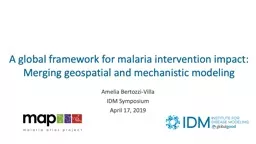

Merging geospatial and mechanistic modeling Amelia BertozziVilla IDM Symposium April 17 2019 We just learned how to use transmission models machine learning to generate highquality risk maps ID: 912394
Download Presentation The PPT/PDF document "A global framework for malaria intervent..." is the property of its rightful owner. Permission is granted to download and print the materials on this web site for personal, non-commercial use only, and to display it on your personal computer provided you do not modify the materials and that you retain all copyright notices contained in the materials. By downloading content from our website, you accept the terms of this agreement.
Slide1
A global framework for malaria intervention impact: Merging geospatial and mechanistic modeling
Amelia Bertozzi-VillaIDM SymposiumApril 17, 2019
Slide2We just learned how to use transmission models + machine learning to generate high-quality risk maps.
Slide3I’d like to talk about using high-quality maps + a complex model to generate intervention impact predictions.
Slide41. Generating Transmission Archetypes
Slide5Once you’ve made a model, you want to explore how it works in different archetypal settings.
For malaria, the key variables usually relate to climate, mosquito bionomics, and baseline transmission.
Griffin et al.,
PLoS
Medicine
2010
All Species
An.
gambiae
An.
funestus
An.
arabiensis
Slide6Archetypes are often found heuristically.
Good way to showcase the versatility and/or sensitivity of the model.
Difficult to predict outcomes for new sites.
All Species
An.
gambiae
An.
funestus
An.
arabiensis
Griffin et al.,
PLoS
Medicine
2010
Slide7When you have detailed covariates on model-relevant variables, you can use them to define archetypes a priori.
Slide8General strategy: dimensionality reduction + clustering
Slide9We use SVD and K-means to find archetypes.
CHIRPS Rainfall
(monthly, synoptic)
MAP Temp Suitability
(monthly, synoptic)
MAP Relative Vector Abundance
(
gambiae
/
arabiensis
/
funestus
,
static)
SVD
Slide10We use SVD and K-means to find archetypes.
Slide11Resultant archetypes capture key seasonality zones.
Slide122. Finding Simulation Outputs
Slide1340%
Bednet coverage (annual distribution)
40% Indoor residual spraying (annual distribution)40% Probability of treatment given a clinical case
Run many simulations to construct an intervention impact curve.
Slide1440%
Bednet coverage (annual distribution)
40% Indoor residual spraying (annual distribution)40% Probability of treatment given a clinical case
Run many simulations to construct an intervention impact curve.
Slide1540%
Bednet coverage (annual distribution)
40% Indoor residual spraying (annual distribution)40% Probability of treatment given a clinical case
Run many simulations to construct an intervention impact curve.
Slide1640%
Bednet coverage
(annual distribution)40% Indoor residual spraying (annual distribution)
40% Probability of treatment given a clinical case
Run many simulations to construct an intervention impact curve.
Slide1740%
Bednet coverage
(annual distribution)40% Indoor residual spraying (annual distribution)
40% Probability of treatment given a clinical case
Run many simulations to construct an intervention impact curve.
Slide18Existing intervention efficacy depends strongly on indoor biting.
40% Bednets
40% Indoor residual spraying40% Probability of treatment
Slide19Novel outdoor interventions have more nuanced effects.
Attractive Targeted Sugar Baits, 5% Kill Rate
Slide20Combining the two, indoor biting still matters.
40% Bednets
40% Indoor residual spraying40% Probability of treatment
Attractive Toxic Sugar Baits,
5% Kill Rate
Slide213. Mapping back out the the pixel level
Slide22Start with a MAP prevalence surface.
Slide23For each pixel, extract starting prevalence and archetype.
Initial prevalence: 0.71
Slide24Initial prevalence: 0.71
Find new prevalence for that initial prevalence and archetype.
Slide25Find new prevalence for that initial prevalence and archetype.
0.71
0.39
Initial prevalence: 0.71
Slide26Continue until a new map is constructed.
Slide27Slide28There is still much to explore/affirm in this framework.
Adding intervention history to archetype selectionIncorporating migration and disease importation
Thoroughly assessing uncertainty/sensitivity at every stageComparing to existing forecastsDetailed assessment of results outside of Africa
…
Slide29There are limitations to be aware of…
Not directly calibrated to dataRelies upon previous calibration of model componentsPossible to compare to well-calibrated sites with good data
Only appropriate at certain scales– useful for understanding spatial distribution, but not for prediction on specific pixels.
Slide30…but this framework has many possible uses:
Gain intuition for intervention impact in data-poor sites or for prospective tools.Can be used with any mechanistic model and/or set of input
rasters.
Amenable to uses in interactive dashboards or educational games.
Slide31Thank you.
Jaline
Gerardin
Caitlin
Bever
Josh Proctor
Pete
Gething
Sam Bhatt
Spheres:
rocketpixel